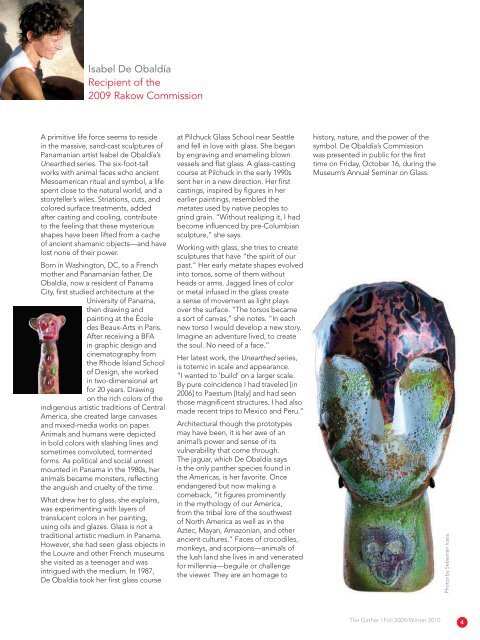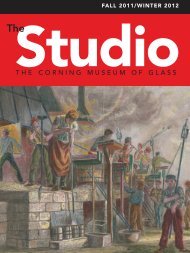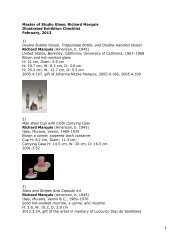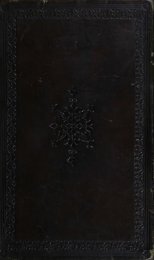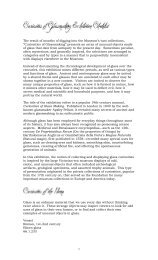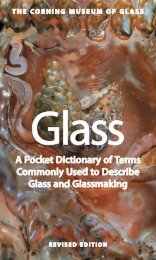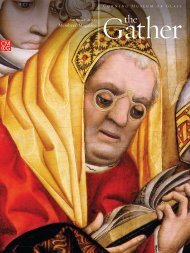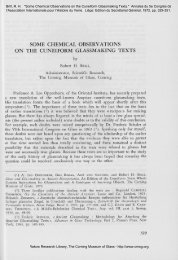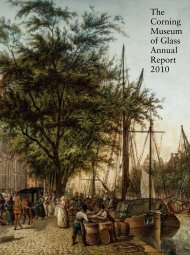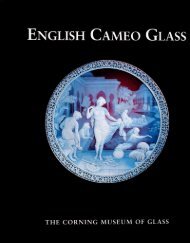The Gather - Corning Museum of Glass Members' Magazine (Fall ...
The Gather - Corning Museum of Glass Members' Magazine (Fall ...
The Gather - Corning Museum of Glass Members' Magazine (Fall ...
Create successful ePaper yourself
Turn your PDF publications into a flip-book with our unique Google optimized e-Paper software.
Isabel De Obaldía<br />
Recipient <strong>of</strong> the<br />
2009 Rakow Commission<br />
A primitive life force seems to reside<br />
in the massive, sand-cast sculptures <strong>of</strong><br />
Panamanian artist Isabel de Obaldía’s<br />
Unearthed series. <strong>The</strong> six-foot-tall<br />
works with animal faces echo ancient<br />
Mesoamerican ritual and symbol, a life<br />
spent close to the natural world, and a<br />
storyteller’s wiles. Striations, cuts, and<br />
colored surface treatments, added<br />
after casting and cooling, contribute<br />
to the feeling that these mysterious<br />
shapes have been lifted from a cache<br />
<strong>of</strong> ancient shamanic objects—and have<br />
lost none <strong>of</strong> their power.<br />
Born in Washington, DC, to a French<br />
mother and Panamanian father, De<br />
Obaldía, now a resident <strong>of</strong> Panama<br />
City, fi rst studied architecture at the<br />
University <strong>of</strong> Panama,<br />
then drawing and<br />
painting at the École<br />
des Beaux-Arts in Paris.<br />
After receiving a BFA<br />
in graphic design and<br />
cinematography from<br />
the Rhode Island School<br />
<strong>of</strong> Design, she worked<br />
in two-dimensional art<br />
for 20 years. Drawing<br />
on the rich colors <strong>of</strong> the<br />
indigenous artistic traditions <strong>of</strong> Central<br />
America, she created large canvases<br />
and mixed-media works on paper.<br />
Animals and humans were depicted<br />
in bold colors with slashing lines and<br />
sometimes convoluted, tormented<br />
forms. As political and social unrest<br />
mounted in Panama in the 1980s, her<br />
animals became monsters, refl ecting<br />
the anguish and cruelty <strong>of</strong> the time.<br />
What drew her to glass, she explains,<br />
was experimenting with layers <strong>of</strong><br />
translucent colors in her painting,<br />
using oils and glazes. <strong>Glass</strong> is not a<br />
traditional artistic medium in Panama.<br />
However, she had seen glass objects in<br />
the Louvre and other French museums<br />
she visited as a teenager and was<br />
intrigued with the medium. In 1987,<br />
De Obaldía took her fi rst glass course<br />
at Pilchuck <strong>Glass</strong> School near Seattle<br />
and fell in love with glass. She began<br />
by engraving and enameling blown<br />
vessels and fl at glass. A glass-casting<br />
course at Pilchuck in the early 1990s<br />
sent her in a new direction. Her fi rst<br />
castings, inspired by fi gures in her<br />
earlier paintings, resembled the<br />
metates used by native peoples to<br />
grind grain. “Without realizing it, I had<br />
become infl uenced by pre-Columbian<br />
sculpture,” she says.<br />
Working with glass, she tries to create<br />
sculptures that have “the spirit <strong>of</strong> our<br />
past.” Her early metate shapes evolved<br />
into torsos, some <strong>of</strong> them without<br />
heads or arms. Jagged lines <strong>of</strong> color<br />
or metal infused in the glass create<br />
a sense <strong>of</strong> movement as light plays<br />
over the surface. “<strong>The</strong> torsos became<br />
a sort <strong>of</strong> canvas,” she notes. “In each<br />
new torso I would develop a new story.<br />
Imagine an adventure lived, to create<br />
the soul. No need <strong>of</strong> a face.”<br />
Her latest work, the Unearthed series,<br />
is totemic in scale and appearance.<br />
“I wanted to ‘build’ on a larger scale.<br />
By pure coincidence I had traveled [in<br />
2006] to Paestum [Italy] and had seen<br />
those magnifi cent structures. I had also<br />
made recent trips to Mexico and Peru.”<br />
Architectural though the prototypes<br />
may have been, it is her awe <strong>of</strong> an<br />
animal’s power and sense <strong>of</strong> its<br />
vulnerability that come through.<br />
<strong>The</strong> jaguar, which De Obaldía says<br />
is the only panther species found in<br />
the Americas, is her favorite. Once<br />
endangered but now making a<br />
comeback, “it fi gures prominently<br />
in the mythology <strong>of</strong> our America,<br />
from the tribal lore <strong>of</strong> the southwest<br />
<strong>of</strong> North America as well as in the<br />
Aztec, Mayan, Amazonian, and other<br />
ancient cultures.” Faces <strong>of</strong> crocodiles,<br />
monkeys, and scorpions—animals <strong>of</strong><br />
the lush land she lives in and venerated<br />
for millennia—beguile or challenge<br />
the viewer. <strong>The</strong>y are an homage to<br />
history, nature, and the power <strong>of</strong> the<br />
symbol. De Obaldía’s Commission<br />
was presented in public for the fi rst<br />
time on Friday, October 16, during the<br />
<strong>Museum</strong>’s Annual Seminar on <strong>Glass</strong>.<br />
<strong>The</strong> <strong>Gather</strong> | <strong>Fall</strong> 2009/Winter 2010<br />
Photos by Sebastian Icaza.<br />
4


